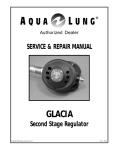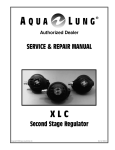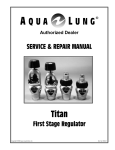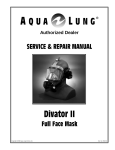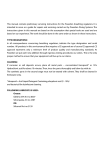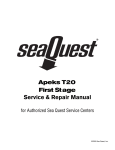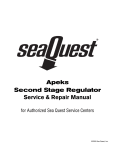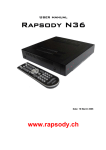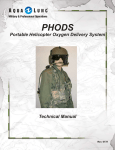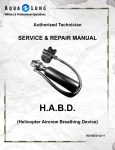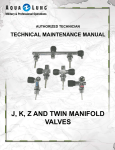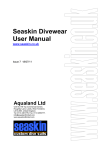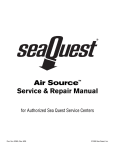Download LPO Second Stage
Transcript
® Authorized Dealer SERVICE & REPAIR MANUAL LPO Second Stage Regulator Copyright ©2000 Aqua Lung America, Inc. Doc. No. XXXX-XX Contents Introduction .................................................................................................... 1 Warnings, Cautions, & Notes ........................................................................................... 1 Scheduled Service ........................................................................................................... 1 General Guidelines ........................................................................................................... 1 Initial Inspection Procedure .......................................................................... 2 External Inspection ........................................................................................................... 2 Pressure Test .................................................................................................................... 2 Disassembly Procedures ............................................................................... 3 Reassembly Procedures................................................................................ 6 Valve Adjustment Procedures....................................................................... 8 Final Assembly & Testing Procedures ......................................................... 9 Second Stage Air Flow Test ............................................................................................ 10 Second Stage Opening Effort Test ................................................................................. 10 Second Stage Purge Flow Test ...................................................................................... 10 External Leak Test .......................................................................................................... 11 Subjective Breathing Test ............................................................................................... 11 Table 1 – Troubleshooting Guide ................................................................ 12 Table 3 – Standard Parts Replacement Schedule ..................................... 13 Table 2 – Recommended Tool List .............................................................. 13 Table 5 – Test Bench Specifications ........................................................... 14 Table 4 – Torque Specifications .................................................................. 14 Procedure A – Cleaning & Lubrication....................................................... 15 Table A – Recommended Lubricants & Cleaners ...................................... 16 Schematic Drawing – LPO Second Stage .................................................. 17 Doc. #XXXX-XX Service & Repair Manual - LPO Second Stage Regulator Introduction GENERAL GUIDELINES This manual provides factory prescribed procedures for the service and repair of the LPO second stage regulator. It is not intended to be used as an instructional manual for untrained personnel. The procedures outlined within this manual are to be performed only by personnel who have received factory authorized training through a factory sponsored Aqua Lung Service & Repair Seminar. If you do not completely understand all of the procedures outlined in this manual, contact Aqua Lung to speak directly with a Technical Advisor before proceeding any further. 1. 2. Warnings, Cautions, & Notes Pay special attention to information provided in warnings, cautions, and notes that are accompanied by one of these symbols: A WARNING indicates a procedure or situation that may result in serious injury or death if instructions are not followed correctly. 3. 4. A CAUTION indicates any situation or technique that will result in potential damage to the product, or render the product unsafe if instructions are not followed correctly. A NOTE is used to emphasize important points, tips, and reminders. Scheduled Service 5. Regulators should be given the same care and maintenance as life support equipment. It is therefore important to perform scheduled overhaul service for the LPO, complete with first stage, according to the procedures outlined in this manual; at least once 6. a year with normal or infrequent use. NOTE: A unit that receives heavy or frequent use, such as in rental, instruction, or commer7. cial applications, should be serviced at least twice each year - or more often - depending on the conditions of use and the manner in which it is maintained. (Refer to the care and maintenance procedures outlined in the Regulator Owner’s Manual.) In order to correctly perform the procedures outlined in this manual, it is important to follow each step exactly in the order given. Read over the entire manual to become familiar with all procedures before attempting to disassemble or service the LPO second stage, and to learn which specialty tools and replacement parts will be required. Keep the manual open beside you for reference while performing each procedure. Do not rely on memory. All service and repair should be carried out in a work area specifically set up and equipped for the task. Adequate lighting, cleanliness, and easy access to all required tools are essential for maintaining a professional repair facility. Before beginning any disassembly, it is important to first perform the Initial Inspection procedure, and refer to Table 1 - Troubleshooting to determine the possible cause of any symptoms which may be present. As each individual regulator is disassembled, reusable components should be segregated to prevent them from mixing with non-reusable parts or parts from other regulators. Delicate parts, and those which contain critical sealing surfaces, must be protected and isolated from other parts to prevent damage during the cleaning procedure. Use only genuine Aqua Lung parts purchased directly from Aqua Lung when servicing any Aqua Lung product. Substitution with another manufacturer’s parts constitutes an after-market modification of the product, and renders the original warranty null and void. Do not attempt to reuse mandatory replacement parts under any circumstances, regardless of the amount of use the product has received since it was manufactured or last serviced. When reassembling, it is important to follow every torque specification prescribed in this manual, using a calibrated torque wrench. Most parts are made of either marine brass or plastic, and can be permanently damaged by undue stress caused by overtightening. LPO Second Stage Service & Repair Manual 2 Initial Inspection Procedure EXTERNAL INSPECTION 1. Visually inspect the sintered filter to check for any signs that contaminants may have entered the system, such as moisture, rust, aluminum oxide, or charcoal. NOTE: A green discoloration positively indicates that moisture has entered the regulator, and internal corrosion is therefore likely to be found in the first stage. A white or rust colored residue usually indicates that the regulator has been used with a corroded aluminum or steel cylinder. Advise the customer of the proper methods for maintaining the regulator, and the possible need to obtain service for their cylinder. 2. Slide back the hose protector(s) to inspect the condition of the LP hose at its fittings and along its length. Check closely for any signs of blistering or abrasion, or corrosion of the fittings. 3. Inspect the condition of the mouthpiece to check for torn bite tabs, holes, or deterioration. PRESSURE TEST 1. Prior to performing any disassembly, ensure that the second stage is connected to a first stage with a stable intermediate pressure of 135-140 psi, with no open ports or hoses. 2. Listen closely to check for any signs of leakage from the second stage. If necessary, immerse the second stage in water to locate the source of any leakage found and refer to Table 1 - Troubleshooting to determine its possible cause. CAUTION: If the second stage freeflows uncontrollably, immediately shut the cylinder valve and proceed directly to the Disassembly Procedure. Do not attempt to further inspect the regulator while pressurized. 3. Depress the purge button to determine whether sufficient airflow is provided to clear the second stage of water. Immediately after releasing the purge button, listen closely to ensure that no air continues to flow from the second stage. 4. Turn the cylinder valve shut and depress the second stage purge button to depressurize the regulator before proceeding to the following Disassembly Procedure. © 2000 Aqua Lung America, Inc. LPO Second Stage Service & Repair Manual 3 Disassembly Procedures NOTE: Before performing any disassembly, refer to Table 4, which references all mandatory replacement parts. These parts must be replaced with new, and must not be reused under any circumstances - regardless of the age of the regulator or how much use it has received since it was last serviced. CAUTION: To prevent damage to critical sealing surfaces, use only a plastic or brass O-ring removal tool (P/N 9440-22) when removing O-rings. Once an O-ring sealing surface has been damaged, the part must be replaced with new in order to prevent the possibility of leakage. DO NOT use a dental pick, or any other type of steel instrument. 1. While holding the inlet fitting(19) of the second stage secure with a 19mm open end wrench, apply a 17mm (n") openend wrench to the female fitting of the LP hose(23). Turn the fitting counter-clockwise to loosen and remove the hose from the second stage. Remove the O-rings(22&24) from the hose and discard. Set the hose aside. 2. Carefully snip the plastic mouthpiece clamp(14) and remove the mouthpiece(13) from the box bottom(15). Inspect the mouthpiece to ensure it is free of any tears or cuts that may cause leakage of water into the second stage or other discomfort. Discard the mouthpiece or set it aside to be reused, depending on its condition. 3. While holding the second stage secure, firmly grasp the color ring(2) which holds the purge cover(1), and turn it counterclockwise to loosen and remove from the box bottom. 4. While holding the color ring with both hands, press inward against the top of the purge cover to remove it from the color ring. Closely examine the color ring for any signs of thread damage, and inspect the purge cover to check for any signs of deterioration, distortion, or other damage. Replace with new if any damage is found, or set these parts aside if they are in reusable condition. 5. Lift out the diaphragm(4) with retaining ring(3) and separate these items to closely inspect the diaphragm for any signs of tears, deterioration, or other damage. If deterioration or damage is found, discard the diaphragm and do not attempt to reuse. 6. While holding the box bottom secure, apply a 19mm open end wrench to the inlet fitting(19). Hold the lever(10) depressed, and carefully turn the fitting counter-clockwise to loosen and remove. Remove and discard the O-ring(18). 7. Apply a medium blade screwdriver to the slotted head of the crown(20) inside the inlet fitting, and hold the inlet fitting © 2000 Aqua Lung America, Inc. LPO Second Stage Service & Repair Manual 4 secure while turning the crown counter-clockwise to disengage the threads. NOTE: Because the crown is O-ring sealed, it will not freely exit the valve body after it has been disengaged. The following step must be performed correctly in order to remove the crown without damaging its delicate sealing surface. 8. When the crown has been unthreaded from the inlet fitting, carefully insert the pin of the extraction tool (P/N 1094-36) into the opposite end of the inlet fitting and through the center of the crown. Gently press the crown out onto a padded surface (see Fig. 1). Remove and discard the O-ring(21). 9. Closely examine the crown with the use of magnifier to check for any scoring, nicks, or other damage to the polished sealing surface. If damage is found, discard the crown, and do not attempt to reuse. If it is in reusable condition, set it aside on a soft surface to prevent damage to the sealing edge. Fig. 1 – Crown Removal 10. Press the valve body(9) with lever assembly into the box bottom by inserting a finger through the inlet opening. Gently lift the assembly out of the box bottom, being careful to avoid pulling or tugging on the lever(10). 11. Stand the valve assembly vertical on the head of the poppet, with the lever facing up, and depress the valve body to expose the locknut(12). While holding the valve body fully depressed, apply a 4" nut driver to turn the locknut counterclockwise until it has disengaged from the threads of the poppet (see Fig. 2). Remove the locknut, washer(11), and lever, and slowly relax the valve body to lift it off the poppet(6) and spring(7). Discard the locknut, and do not attempt to reuse. 12. Closely inspect the shape and condition of the lever to ensure it is not bent, corroded, or otherwise damaged. If any signs of damage or corrosion are found, discard the lever and do not reuse. 13. Closely examine the poppet spring with a magnifier to ensure it is not damaged (bent) or corroded. If any signs of damage or corrosion are found, discard the spring and do not reuse. 14. Using a plastic or brass O-ring tool, lightly stick the center of the LP seat(5) inside the head of the poppet and lift the seat out, being very careful to avoid damaging the poppet. Set the seat aside to be used as an aid during reassembly, and inspect the head of the poppet to check for any nicks, scratches, or other signs of damage. The through-hole beneath the LP seat cavity should be clear and free of any obstructions. If any signs of damage are found, discard the poppet and do not attempt to reuse. © 2000 Aqua Lung America, Inc. Fig. 2 – Disassembly of Valve LPO Second Stage Service & Repair Manual 5 NOTE: The used LP seat is an essential aid to the reassembly procedure for the valve body. Do not discard the seat until the reassembly and final adjustment procedures have both been performed, and the regulator is functioning satisfactorily. 15. Place the handle of the extraction tool directly over the poppet bearing(8) in the top center of the valve body, and press downward until the poppet bearing has dropped out. Discard the poppet bearing, and do not reuse. 16. To remove the exhaust valve diaphragms(16), it is not necessary to remove the exhaust cover(17). Instead, use a pair of needle nose pliers to pull each of the diaphragms through the grill of the exhaust cover (see Fig. 3). Discard both diaphragms, and do not reuse. Fig. 3 – Removing Exhaust Diaphragms CAUTION: Aqua Lung recommends that the exhaust cover should not be removed unless it appears to be damaged and requires replacement. If removal and replacement is necessary, proceed with caution, being careful to avoid damaging the box bottom. This concludes the disassembly of the LPO second stage. Refer directly to Procedure A and Table A, titled Cleaning & Lubrication, before proceeding to the Reassembly Procedures. © 2000 Aqua Lung America, Inc. LPO Second Stage Service & Repair Manual 6 Reassembly Procedures NOTE: Before performing any reassembly, it is important to inspect all parts, both new and those that are being reused, to ensure that every part and component is perfectly clean and free of any dust, corrosion, or blemishes. Check all Orings to ensure they are clean and supple before dressing with either Christo-Lube® or Dow 111 silicone grease. WARNING: Use only genuine Aqua Lung parts, subassemblies, and components whenever assembling any Aqua Lung product. DO NOT attempt to substitute an Aqua Lung part with another manufacturer’s, regardless of any similarity in shape, size, or appearance. Doing so may render the product unsafe, and could result in serious injury or death. 1. Install each exhaust valve diaphragm(16) into the box bottom(15) by feeding the stem of the diaphragm through the exhaust cover(17) and into the center hole of the valve in the box bottom. Gently pull the stem through the hole on the opposite side inside the box bottom, until the barb has passed through and is securely seated against the opposite side. Carefully snip off the excess material of each stem with a small pair of scissors. 2. Install the O-ring(21) onto the crown(20), and carefully insert the threaded end of the crown into the hose connection of the inlet fitting(19). Gently press it in further with the blunt end of the extraction tool (P/N 1094-36) until it stops (see Fig. 4). 3. Apply a medium blade screwdriver to the slotted head of the adjustable crown, and turn the crown clockwise to engage the threads. Continue turning the crown clockwise to the full extent of its thread engagement, and stop turning when resistance is felt. Then turn the crown out counter-clockwise exactly 22 turns counterclockwise to arrive at its correct preliminary setting. 4. Stand the inlet fitting vertical on a flat surface with the sealing edge of the crown facing up inside. Install the O-ring(18) into the groove at the base of the threads, just above the hex feature. 5. Lay the previously used LP seat inside the inlet fitting, over the sealing edge of the crown (see Fig. 5). NOTE: It is essential to use a spare LP seat in order to prevent damage to the new seat while performing the following steps of the reassembly procedure. 6. Place the poppet bearing(8) over the pin of the extraction tool with the square feature facing up. Guide the pin of the tool into the open end of the valve body(9) and out through the square hole in its center. While sighting through the top of © 2000 Aqua Lung America, Inc. Fig. 4 – Crown Installation Fig. 5 – Using Old LP Seat as Spacer LPO Second Stage Service & Repair Manual 7 the valve body, rotate the tool as needed to align the square feature of the poppet bearing with the square hole, and press the tool upward to seat the bearing securely in place (see Fig. 6). When finished, check to ensure that the top of the poppet bearing is flush with the top of the valve body. Fig. 6 – Poppet Bearing Installation 7. Press the new LP seat(5) into the cavity in the head of the poppet(6), with the smooth side facing out. 8. Stand the poppet on its head inside the top of the inlet fitting, and place the spring(7) over the poppet shaft. 9. Hold the inlet fitting secure, and mate the valve body with poppet bearing down over the poppet shaft. Press the valve body downward to compress the spring while turning it clockwise to engage the threads of the inlet fitting, and then continue turning it slowly until the threaded portion of the poppet shaft stands outside the poppet bearing. CAUTION: If resistance is felt, immediately stop and unscrew the valve body from the inlet fitting to check the alignment of the poppet shaft and poppet bearing. Excessive force and misalignment will otherwise result in damage to the poppet bearing, requiring its replacement. 10. While the inlet fitting and valve body are laying horizontal, rotate both parts until the outlet ports of the valve body face towards 6 O’clock. Lay the arms of the lever(10) inside the groove of the valve body, straddling the poppet shaft, so that the curved portion of the lever faces towards 12 O’clock. 1-2 threads Fig. 7 – Locknut Preliminary Setting 11. Place the washer(11) over the poppet shaft, followed by the locknut(12), with the flat side facing down. Being careful to avoid disturbing the lever, turn the locknut clockwise by hand to engage the threads of the poppet, and then apply a 4" nut driver to turn it further; only until 1 thread of the poppet shaft is visible above the top of the locknut (see Fig. 7). 12. Hold the valve body and lever stationary and upright with one hand, and slowly unscrew the inlet fitting counter-clockwise to loosen and remove from beneath it, while watching to ensure that the lever rises slightly as the poppet shaft retracts into the valve body. Remove and discard the previously used LP seat from the inlet fitting. 13. After removing the previously used LP seat, reconnect the valve body and inlet fitting and tighten finger snug so that they are flush with each other. NOTE: This concludes the preliminary reassembly procedures of the main valve assembly. Do not proceed to reassemble the LPO second stage any further until first following the adjustment procedures for the valve assembly outlined in the following section. © 2000 Aqua Lung America, Inc. LPO Second Stage Service & Repair Manual 8 Valve Adjustment Procedures CAUTION: Prior to adjusting and testing the LPO second stage regulator, the accompanying first stage must be correctly serviced, adjusted to a stable intermediate pressure of 135-140 psi, and fully tested. Refer to the appropriate first stage service manual before attempting to perform the adjustment and testing of the LPO second stage. 1. 2. 3. 4. 5. Thread the male fitting of the IP hose into the low pressure port of the first stage, and apply a torque wrench with 17mm (n") crow-foot to tighten to 40 inch-pounds (±2). Connect an intermediate pressure test gauge (P/N 1116-10) to the first stage via a separate low pressure hose. Attach the female fitting of the second stage low pressure hose to the Inline Adjustment Tool (P/N 1001-95) by mating the swivel nut onto the male threaded end of the tool. Turn the swivel nut clockwise until finger snug. Pull back the knob of the tool to retract the adjusting stem, and mate the female threaded end of the tool onto the second stage inlet fitting. While holding the tool secure, turn the valve assembly clockwise until finger snug (see Fig. 8). Slowly open the valve of the air supply to pressurize the valve assembly. Press the knob of the inline adjustment tool inward, and gently turn the knob until it can be felt that the adjustment stem has mated into the slotted head of the crown. Continue to hold the knob inward, in order to prevent it from being pressed outward by the internal air pressure. a. If airflow cannot be heard, slowly turn the crown out counter-clockwise only until a very slight leak is present. b. When a slight leak has been established, slowly turn the crown clockwise in very small increments of adjustment while lightly depressing the lever to cycle the regulator. Pause to listen after each adjustment to determine whether the airflow has stopped. It is important to adjust only until the airflow has stopped. c. When the airflow is stopped and no leakage can be heard after cycling the regulator, proceed to adjust the crown further clockwise exactly 180 degrees. Then, release the knob of the inline adjustment tool to ensure that it no longer makes contact with the crown. Fig. 8 – Inline Tool Connection 1–2 mm freeplay while pressurized CAUTION: Over-adjustment of the orifice crown will cause excessive spring load in the second stage valve, and may severely degrade the performance of the regulator. 6. Apply a hand driver with 4" tapered hex to turn the locknut clockwise in very small increments of adjustment; only until the lever stands just below its maximum height; with a very slight amount (1–2 millimeters) of freeplay (see Fig. 9). © 2000 Aqua Lung America, Inc. Fig. 9 – Lever Height Adjustment LPO Second Stage Service & Repair Manual 7. 9 Lightly depress the lever several times to cycle the regulator and listen closely to check for the return of any leakage, which may indicate that the locknut has been over-adjusted. If leakage is detected, it is important to return the crown and locknut to their original preliminary settings, and then repeat steps 5-6 before proceeding any further. CAUTION: Over-adjustment of the locknut will retract the poppet from the crown, resulting in leakage past the LP seat. Do not attempt to correct this condition by only readjusting the crown further in clockwise. Doing so may increase the opening effort and inhalation resistance of the regulator due to excessive spring load in the second stage valve. 8. When the crown and locknut are properly set with no leaks and the lever is standing at its correct height, turn the valve of the air source completely shut, and lightly depress the lever to depressurize the system. Disconnect the in-line adjustment tool from the second stage valve assembly. 9. While holding the lever partially depressed, unscrew the inlet fitting from the valve body and set it aside. Final Assembly & Testing Procedures Fig. 10 – Installing Valve Assembly 1. Lay the valve body and lever assembly inside the box bottom with the lever facing up. Mate the valve body into the inlet port of the box bottom until it is seated flush against the wall inside (see Fig. 10). 2. While holding the valve body securely seated inside the box bottom and the lever partially depressed, mate the shorter threaded end of the inlet fitting through the port of the box bottom. Turn the inlet fitting clockwise by hand until finger snug, and then apply a torque wrench with a 19mm socket to tighten it to a torque measurement of 50 (±5) inch-pounds. 3. Lay the purge cover(1) over the top of the color ring(2) with the logo facing up, and align the indexed tab on the side of the purge cover with the slot inside the center of the color ring (see Fig. 11). Press the purge cover into the color ring, beginning with the indexed tab. When done, check to ensure that it is seated evenly around its entire circumference. 4. Lay the diaphragm(4) inside the box bottom, directly over the lever, with its raised center facing up. Check to ensure it is evenly seated over the shoulder on all sides at the base of the threads. Then, place the retaining ring(3) directly over the diaphragm with the raised shoulder facing up, and press it firmly downward to ensure it is seated evenly on all sides at the base of the threads. 5. Mate the color ring with purge cover over the box bottom, and turn the color ring clockwise to tighten until finger snug. Fig. 11 – Purge Cover Alignment © 2000 Aqua Lung America, Inc. LPO Second Stage Service & Repair Manual 10 6. Install the mouthpiece(13) onto the box bottom, and lightly fasten a clamp(14) onto the groove of the mouthpiece. Turn the clamp so that the locking tab is facing toward the inlet side of the box bottom, and pull the clamp sufficiently snug. Snip the extra length with a small pair of scissors or wire cutters. NOTE: Before performing the following procedure, refer to Table 5, titled Test Bench Specifications - LPO 2nd Stage. NOTE: If an accurately calibrated airflow test bench is not available, proceed to the Subjective Tuning Procedures provided on the following page. SECOND STAGE AIR FLOW TEST 1. Connect the first stage regulator to a calibrated test bench and pressurize the system to 3000 (±100) psi. 2. Place the second stage mouthpiece over the mouthpiece adapter. Slowly turn the flowmeter control knob until the flow reaches a minimum of 15 SCFM (425 liters per minute). The reading on the Magnahelic gauge (inhalation / exhalation effort gauge) should indicate no more than +6.O" H2O. If the reading exceeds +6.0" H2O, refer to refer to Table 1 - Troubleshooting for corrective guidelines and specific procedures. SECOND STAGE OPENING EFFORT TEST 1. Turn the flowmeter control knob shut, and then slowly reopen while watching both the Magnahelic gauge and the intermediate pressure gauge. 2. When the intermediate pressure gauge begins to drop below the intermediate pressure “lockup,” the Magnahelic gauge should indicate an opening effort of +.8" to +1.4" of H2O (primary) or +1.2" to +1.8" (octopus). If the opening effort is not within this range, refer to Table 1 - Troubleshooting. SECOND STAGE PURGE FLOW TEST 1. Turn off the flowmeter control knob. Next, while the second stage is still mounted on the mouthpiece adapter, watch the flowmeter gauge and depress the purge button until the second stage valve is completely open. The flowmeter gauge must indicate a minimum of +5.0 SCFM (142 Liters per minute.). If the purge flow is less than +5.0 SCFM, refer to Table 1 - Troubleshooting. 2. When purge flow is correct, remove the second-stage from the mouthpiece adapter on the flow test bench. Shut the valve of the test bench, and purge the second stage to depressurize the system. Remove the regulator. © 2000 Aqua Lung America, Inc. LPO Second Stage Service & Repair Manual 11 EXTERNAL LEAK TEST 1. After disconnecting the regulator from the flow bench, connect it to a scuba cylinder filled to approximately 3,000 psi. Open the cylinder valve to repressurize the regulator, and submerge the entire system in a test tank of clean water. 2. Observe any bubbles arising from the submerged regulator over a one minute period. The recommended time is necessary due to slower bubble formation that occurs in smaller leaks. Bubbles indicate a leak, which requires that the system must be disassembled at the source to check sealing surfaces, assembly sequence and component positioning in order to correct the problem(s). NOTE: Extremely small leaks may be better detected by applying a soap solution or Snoop™ to the leak area. Bubble streams will indicate the source of the leak. Before disassembling to correct any leaks, rinse the entire regulator thoroughly with fresh water and blow out all residual moisture with filtered, low-pressure (50 psi) air. Disassemble and remedy the problem, referring to Table 1 - Troubleshooting. SUBJECTIVE BREATHING TEST 1. Depress the purge cover fully to ensure that an adequate volume of air needed to clear the second stage flows through the mouthpiece. Then, inhale slowly but deeply from the mouthpiece. A properly serviced and adjusted regulator should deliver air upon deep inhalation without excessive inhalation effort, freeflow, or “fluttering” of the second-stage diaphragm. When exhaling, there should be no fluttering or sticking of the exhalation valve. If any of these problems occur, refer to Table 1 - Troubleshooting. This concludes annual service procedures for the LPO Second Stage. © 2000 Aqua Lung America, Inc. LPO Second Stage Service & Repair Manual 12 Table 1 Troubleshooting Guide – LPO Second Stage SYMPTOM Leakage or freeflow from second stage Low purge or excessive work of breathing (full cylinder) External air leakage Water entering second-stage POSSIBLE CAUSE TREATMENT 1. High first-stage intermediate pressure. (should be 135-140 psi) 1. Refer to first-stage Troubleshooting Guide. 2. LP seat(5) damaged or worn. 2. Replace LP seat. 3. Crown(20) and/or locknut(12) adjusted incorrectly, lever set too high. 3. Reset crown and locknut to preliminary settings, and repeat Adjustment Procedures. 4. Crown(20) sealing surface damaged. 4. Replace crown. 5. Poppet spring(7) damaged. 5. Replace poppet spring. 1. Low intermediate pressure. (should be 135-140 psi) 1. Refer to first-stage Troubleshooting Guide. 2. Crown(20) and/or locknut(12) adjusted incorrectly, lever set too low. 2. Reset crown and locknut to preliminary settings, and repeat Adjustment Procedures. 3. Intermediate pressure hose(23) clogged or obstructed. 3. Clean or replace hose. 1. Intermediate pressure hose(23) loose. (Immersion Test) 1. Tighten to 40 inch-lbs at female second-stage fitting. 2. Crown O-ring(21) damaged. 2. Disassemble and replace O-ring. 3. Box bottom(15) damaged. 3. Disassemble and replace box bottom. 1. Hole in mouthpiece(13). 1. Replace mouthpiece. 2. Demand diaphragm(4) damaged. 2. Replace demand diaphragm. 3. Exhaust diaphragm(16) damaged. 3. Replace exhaust diaphragm(s). 4. Diaphragm(4) improperly seated between box bottom(15) and retaining ring(3). 4. Remove color ring(2) and properly reassemble sealing ring with diaphragm . (Check for distortion.) 5. Box bottom(15) damaged. (Check exhaust valve sealing surface.) 5. Disassemble and replace box bottom. 6. Valve insert O-ring(18) damaged. 6. Disassemble and replace O-ring. CAUTION: Recommended treatments which require disassembly of the regulator must be performed during a complete overhaul, according to the prescribed procedures for scheduled, annual service. Do not attempt to perform partial service. NOTE: This is a partial list of possible problems and recommended treatments. For more information, refer to the second-stage troubleshooting guide, or contact the Repair Department for assistance with problems not described here. © 2000 Aqua Lung America, Inc. LPO Second Stage Service & Repair Manual 13 Table 2 Recommended Tool List PART NO. 1116-10 DESCRIPTION APPLICATION I.P. test gauge Intermediate pressure testing 0-120 inch-lbs torque wrench Inlet & hose fittings installation O-ring tools O-ring removal & installation N/A Magnifier w/ illumination Sealing surface inspection N/A Ultrasonic cleaner Brass & stainless steel parts cleaning N/A Medium blade screwdriver Crown removal/ installation N/A 17mm (n") wrench & crow foot IP hose fitting N/A 4" nut driver Valve disassembly/ assembly/ adjustment 1094-36 Seat extraction/installation tool Crown removal & installation 1001-95 In-line adjustment tool Final adjustment & tuning N/A 9440-22 Table 3 Standard Parts Replacement Schedule PART NUMBER DESCRIPTION KEY NUMBER QTY 1025-10 Locknut 12 1 1041-34 Poppet Bearing 8 1 1067-38 LP Seat 5 1 8200-11 O-ring 24 1 8200-10 O-ring 21 & 22 2 8200-15 O-ring 18 1 1049-13 Clamp 14 1 1078-22 Exhaust Diaphragm 16 2 © 2000 Aqua Lung America, Inc. LPO Second Stage Service & Repair Manual 14 Table 4 Torque Specifications PART NUMBER DESCRIPTION / KEY NUMBER TORQUE 0900-39 LP Hose Female Fitting / 23 40 (±3) inch-lbs 1041-06 Inlet Fitting/ 19 50 (±5) inch-lbs Table 5 Test Bench Specifications TEST CONDITION ACCEPTABLE RANGE Leak test Inlet 2,500-3,000 (±100) psi None Intermediate pressure Inlet 2,500-3,000 (±100) psi 135-140 psi Intermediate pressure creep Inlet 2,500-3,000 (±100) psi 5 psi max between 5 to 15 seconds after cycling regulator (purge) Opening effort Inlet 2,500-3,000 (±100) psi, intermediate pressure 135-140 psi +.8 to +1.4 inch H20 (primary) +.8 to +1.8 inch H20 (octopus) Flow effort Intermediate pressure 135-140 psi at 15 SCFM +6 inches H20 (maximum) Purge flow Intermediate pressure 135-140 psi 5.0 SCFM flow rate (minimum) © 2000 Aqua Lung America, Inc. LPO Second Stage Service & Repair Manual 15 Procedure A Cleaning & Lubrication (All Aqua Lung Regulators) 1. Acid Bath - Aqua Lung strongly recommends ChromeSafe™ regulator cleaner (P/N 0201-05) for cleaning all reusable brass and stainless steel parts. ChromeSafe™ is a specially formulated cleaner that does not harm rubber or Teflon parts, yet effectively removes silicone grease, corrosion, and grime from metal parts, leaving only a brilliant shine. For best results, soak parts in an ultrasonic cleaner for 5 to 15 minutes, unless the chrome finish is chipped or flaking. Parts with damage to their chrome finish should be cleaned separately outside the ultrasonic cleaner to avoid agitation. Be certain to isolate more delicate parts, such as orifice cones, to prevent damage to sealing surfaces. CAUTION: Harsh acids, such as muriatic acid, may cause damage to parts and must be strictly avoided. White vinegar, although less effective, is one suitable substitute for ChromeSafe™. CAUTION: Ultrasonic cleaning times in excess of 15 minutes may damage the chrome finish of certain parts. Be certain to use a timer, and do not leave parts unattended while cleaning. NOTE: Although ChromeSafe™ contains a degreasing agent, cleaning heavily greased parts in ChromeSafe™ will shorten the effective life of the solution, and require it to be replaced on a more frequent basis. Heavily greased parts may be degreased in a solution of warm water and mild dish detergent prior to being placed in the acid bath. 2. Fresh Water Rinse - If tap water is extremely “hard,” distilled water may be used to prevent any mineral residue. Remove parts from the acid bath and place directly into this rinse. Agitate lightly, and allow to soak for 5-10 minutes. Remove and blow dry with low pressure (25 psi) filtered air, and inspect closely to ensure proper cleaning and like-new condition. ANODIZED ALUMINUM, PLASTIC & RUBBER PARTS Anodized aluminum parts and parts made of plastic or rubber, such as box bottoms, box tops, dust caps, etc., may be soaked and cleaned in a solution of warm water mixed with mild dish soap. Use only a soft nylon toothbrush to scrub away any deposits. Thoroughly blow dry, using low pressure filtered air. HOSES If buildup of corrosion is severe, it is permissible to soak only the hose fittings in ChromeSafe™ cleaner as needed, and not allow any solution to enter the hose. Rinse in fresh water and allow to dry with the cleaned ends hanging down. Blow filtered air through them prior to installing onto the regulator. LUBRICATION AND DRESSING All O-rings should be lubricated with either Christo-Lube® (preferred for high pressure systems) or Dow Corning® 111 food grade silicone grease . Dress the O-rings with a very light film of grease, and remove any visible excess by running the O-ring between thumb and forefinger. Avoid applying excessive amounts of silicone grease, as this will attract particulate matter that may cause damage to the O-ring. Hoses and other black rubber parts may be dressed and preserved using a clean cloth impregnated with a pump silicone milk. CAUTION: Aerosol spray silicone must be strictly avoided. Do not attempt to use as a substitute for silicone grease. CAUTION: Do not apply any form of silicone lubricant to silicone rubber parts, as this will cause them to deteriorate prematurely. © 2000 Aqua Lung America, Inc. LPO Second Stage Service & Repair Manual 16 Table A Recommended Lubricants & Cleaners (All Aqua Lung Regulators) LUBRICANT / CLEANER APPLICATION SOURCE Christo-Lube® All O-rings seals; cylinder valve threads (preferred for high pressure DIN systems) Lubrication Technologies 310 Morton Street Jackson, OH 45640 (614) 286-2644 Dow Corning® 111 (pure silicone grease) All O-ring seals Dow Corning Corp. P.O. Box 1767-T Midland, MI 48640 800-248-2481 CAUTION: Silicone rubber requires no lubrication or preservative treatment. DO NOT apply silicone grease or spray to silicone rubber parts. Doing so will cause a chemical breakdown and premature deterioration of the material. Silicone Pump™ (non-aerosol silicone milk spray) General preservative/conditioner for hoses, instrument console boots, etc. McNett Corp. P.O. Box 996 Bellingham, WA 98227 800-221-7325 CAUTION: Aerosol spray silicone should be avoided because (1) common aerosol propellants may attack plastic and rubber parts, and (2) because only a slight amount of silicone remains after the solvent evaporates, and provides no lasting benefit. Anti-Seize Lubricant #80208 M.A.S. cylinder adapter - female threads Micra ADJ adjustment screw Permatex Industrial Corp. 705 N. Mountain Rd. Newington, CT 06111 (860) 520-5000 ChromeSafe™ (ultrasonic cleaning solution) Degreaser and acid bath for reusable stainless steel and brass parts. Aqua Lung P/N 0201-05 (1 quart) Oakite #31 Acid bath for reusable stainless steel and brass parts. Oakite Products, Inc. 50 Valley Road Berkeley Heights, NJ 07922 White distilled vinegar (100 gr.) Acid bath for reusable stainless steel and brass parts. "Household" grade CAUTION: DO NOT use muriatic acid for the cleaning of any parts. Muriatic acid, even when strongly diluted, can harm chrome plating, and may leave a residue that is harmful to O-ring seals and other parts. Liquid dishwashing detergent (diluted with warm water) Degreaser for brass and stainless steel parts, general cleaning solution for plastic, rubber, and anodized aluminum parts. "Household" grade Snoop™ Leak testing Nupro Company 400 E. 345th St. Willoughby, OH 44094 440-951-7100 © 2000 Aqua Lung America, Inc. LPO Second Stage Service & Repair Manual 17 LPO Second Stage 1 2 3 4 5 6 7 8 10 13 9 12 20 21 19 11 18 14 23 22 15 16 16 17 24 25 Key # Part # ----- 9000-11 1 ----- 1009-04 2 ----- 1009-06 3 ----- 1009-09 4 ----- 1001-81 5 ----- 1067-38 6 ----- 1041-22 7 ----- 1041-27 8 ----- 1041-34 9 ----- 1009-45 10 ---- 1009-23 11 ---- 1041-29 12 ---- 1025-10 13 ---- 1058-31 Description Overhaul Parts Kit Purge Cover Color Ring Retaining Ring Diaphragm LP Seat Poppet Spring Poppet Bearing Valve Body Lever Washer Locknut Mouthpiece Key # Part # 14 ---- 1049-13 15 ---- 1009-03 16 ---- 1009-22 17 ---- 1009-07 18 ---- 8200-15 19 ---- 1041-06 20 ---- 1078-05 21 ---- 8200-10 22 ---- 8200-10 23 ---- 0900-39 24 ---- 8200-11 25 ---- 1009-24 Description Clamp Box Bottom Exhaust Valve Diaphragm Exhaust Cover O-ring Inlet Fitting Adjustable Crown O-ring O-ring LP Hose O-ring Hose Retaining Clip Part numbers in BOLD ITALICS indicate standard overhaul replacement part. © 2000 Aqua Lung America, Inc. 2340 Cousteau Court Vista, California 92083 Phone (760) 597-5000 Fax (760) 597-4900 www.aqualung.com





















